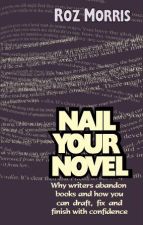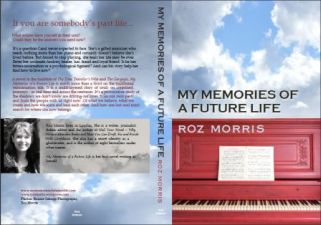I’m excited to share today’s guest post by author Roz Morris. After ghostwriting many bestselling books, Roz recently self-published My Memories of a Future Life, her first novel under her own name.
Roz’s decision to self-publish came about partly because this novel doesn’t fit into normal genre boxes. However, even as a self-published author, she still had to write the back cover copy.
That’s right. Whether we query agents for traditional publishing or self-publish, we have to know how to summarize our book. I’ve mentioned many times that I suck at queries and pitching and all things related to this “boiling down the essence” process, so I asked Roz to walk us through her tips for how to write back cover copy for even the trickiest books.
*****
How to Write Back Cover Copy—No Matter How Difficult Our Book Is to Describe
Back cover copy. A brace of paragraphs—sometimes called the blurb—to woo potential readers. If you’re being published traditionally, you can kick back and be grateful you don’t have to write it. But if you’re self-publishing, welcome to a world of woe.
Some writers have the knack of summarizing their own work. Most of us don’t, though, and are further paralyzed because they’ve spent months eye to eye with every syllable. The ethersphere regularly resounds to the cries of blurbing tweeps and bloggers, chirping, where do I start? What do I leave out?
Tips for Writing Back Cover Copy for Genre Books
I had a right old nightmare writing mine, so here are my tips for getting it done.
1. Immerse yourself in other blurbs
Blurbs have their own language. Go on Amazon, Goodreads or your preferred emporium. Collect blurbs for novels that are like yours and soak up the way they sum up a novel in a brief sweep. Usually they mention the main character, what they want and what’s stopping them. Scroll down to reader reviews too, because sometimes these summarize as well, giving you another run at the same story.
2. Hit your genre’s marks
Genres are about reader expectations. Your blurb must reassure the reader the book has the tropes they like—so notice how these are deployed in the blurbs you read. For steampunk, historical, fantasy, the setting is part of the sizzle. For action thrillers it might be the gritty ex-forces hero. For crime procedural it’s the puzzle.
3. Use feedback from your editor and beta readers
You’ve probably been working with an editor. They won’t usually write your blurb, but their reports and emails are a useful outsider’s view of your book. Same with beta readers. Check back over correspondence to see if something they’ve said should go into your blurb. In particular, look at what makes your book fit in with the genre—and how it stands out.
Once you’re thinking in blurb language, have a stab at your own. You’ll probably need several goes, so after each draft read another batch of back covers like yours and refine. Bounce them off your beta readers if they’re willing.
Just because the blurb is short doesn’t mean it’s easy to write. It may well take a bit of to and fro—and anguished tweeting—to keep yourself sane. That paragraph has got a lot of heavy lifting to do.
The Difficulties of Summarizing Non-Genre Books
BUT… what if you’ve got a non-genre or difficult novel?
If genre is about expectations, in non-genre, anything goes. This causes you problems all over the place, from writing the book to selling it. And of course when writing cover copy.
I got myself in exquisite knots trying to blurb My Memories of a Future Life. It’s a hybrid of literary fiction with a splash of magic realism. Maybe. The other day someone argued for why it was contemporary women’s fiction. Whatever— writing it was tricky enough; blurbing it was murder.
Attempt to Write Back Cover Copy: Part One
Guided by sample blurbs, my first approach was to start with the opening events.
“Carol is a musician who may lose her career because of an injury. Her flatmate is miraculously cured of panic attacks when he is regressed to Victorian England and finds he was killed by Jack the Ripper. Carol gets drawn into a hypnotic journey to another life of her own.” etc etc When I read it to friends, they looked like they’d sat on live electrodes. Result!
Unfortunately, they made the wrong connection. These events are important, but Jack the Ripper is a minor appearance and there’s hardly any other Victoriana. Although it pushed their buttons, it pushed the wrong ones.
Lesson: Every word in a blurb sets up expectations. Use them with care.
My next approach was to describe the first scene, into which I had condensed the themes and the character’s problem in oblique style. “It opens with a scene of yoga rage,” I said to another group of (tolerant) friends. Again, they zapped to attention. Again, for the wrong reasons. The yoga scene was what I used to introduce the character—a situation of enforced stillness she is hating—but it was a detail and misleading when given such prominence. When they heard it in isolation, they were expecting chick-lit. It shortchanged the book as a whole.
Lesson: When blurbing, it’s easy to think of a great soundbite and then become attached to it. Yoga rage is right for the scene, but gives the wrong idea about the book. Just as we have to kill our darlings in the main text, we have to kill our darlings in the blurb too.
Blurbs also need to give a flavor of the book’s mood, and ‘yoga rage’ is totally at odds with that. The story is actually yearning and melancholy.
Attempt to Write Back Cover Copy: Part Two
By this time I thought I’d never have the blurb finished in time for the launch. But all these false starts were leading me to what I needed—as false starts do.
The mood had to be right. I needed to bring out another level underneath the events. I asked myself this: What was Carol’s real crisis? If she couldn’t play the piano, she didn’t belong in her life. Everywhere else she went, she felt like an outsider.
Now we were getting somewhere, and I used this the first time I wrote anything to try to describe the book. How do you find where you belong?
It’s just a logline and it’s not bad, but I was sure I could do better.
Because there was one big, remaining problem. Good blurbs have to hint how the book will live up to its title.
So far, nothing I’d got lived up to the title’s witchy, metaphysical razzmatazz. If you take nothing else away from this post, take this. You snare the reader with the title, so the blurb must go with it.
So I scribbled something about my narrator, what her crisis was and how the title fit in with it all. Meanwhile I had the book out with early reviewers, who helped me fine-tune the blurb here.
Tips for Writing Back Cover Copy for Non-Genre Books
So here are my top tips for blurbing:
- Push the right buttons—don’t lead the reader astray by a minor detail or a darling soundbite
- Make sure your blurb communicates the mood of the book—is it gritty, wisecracking, gentle, melancholy?
- Don’t forget your title does some of the work—make sure blurb and title fit together
Roz Morris is a bestselling ghostwriter and book doctor. She blogs and has a double life on Twitter with writing advice and chit-chat. Follow her at @Roz_Morris.
Her books are Nail Your Novel: Why Writers Abandon Books And How You Can Draft, Fix and Finish With Confidence, available in print and on Kindle.
Her novel My Memories of a Future Life is available on Kindle (US and UK) and also in print. You can also listen to or download a free audio of the first 4 chapters.
Thanks for the great post, Roz! Read what she says here again: “[L]ook at what makes your book fit in with the genre—and how it stands out.” I think that’s the key for genre books.
With non-genre or difficult books, we can’t use genre tropes as shorthand to set up reader expectations. Instead, the words in our pitches, queries, and back cover copy must work harder to convey the mood and type of story it is and establish those expectations from scratch. And we have to make sure we’re establishing the right expectations, as Roz pointed out here, “When blurbing, it’s easy to think of a great soundbite and then become attached to it.” In addition, our words must also give enough insight into the plot and emotional journey of the story to entice readers.
It’s a tricky balance to be sure, and I haven’t found it with my stories yet. *sigh* But wish me luck because I’m trying to get a pitch ready this week. Here’s hoping this post gives us all some new ideas about how to approach the challenge.
Do you have any questions for Roz? Do you have any books that fall outside the typical expectations for a genre? Do you struggle with boiling down the essence of your books? Which piece is hardest for you—genre or story type, tone, or plot or journey details (or all of the above!)? If you’ve tested your copy to see if it sets up the right expectations, how well did it match up? Do you have any other tips to share?



